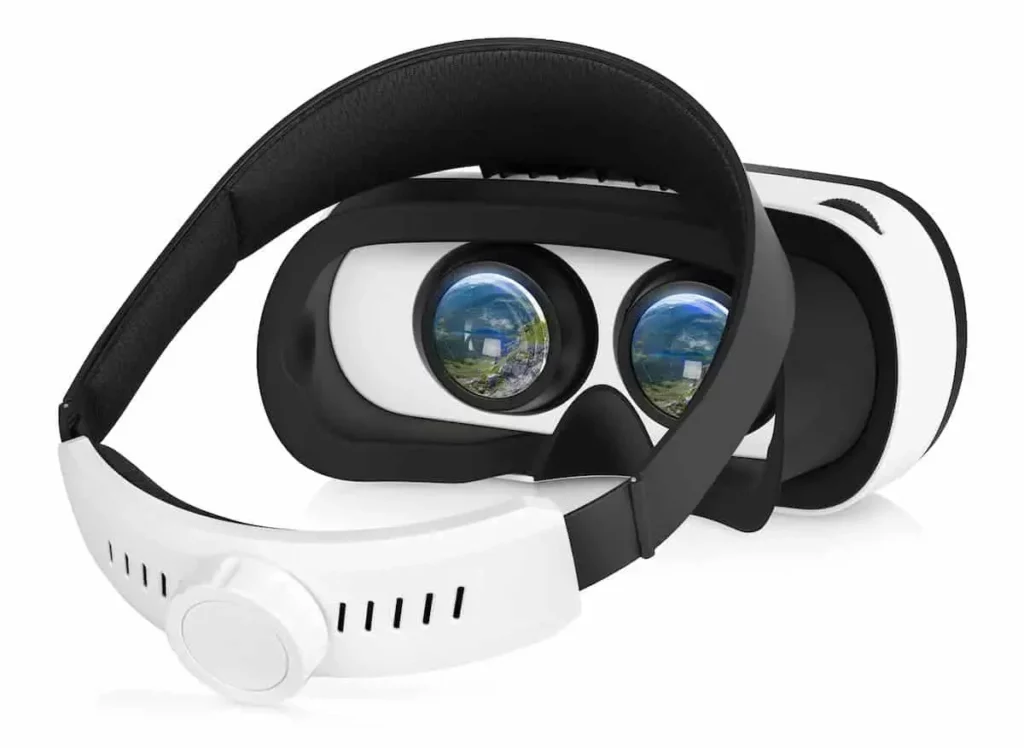erThere’s no doubt that virtual reality (VR) headsets are becoming more and more popular. However, with how pricey VR is its relatively limited game catalog, it’s only natural to wonder if VR Headsets are worth it to buy one. Should you wait it out until the technology is more fleshed out or should you get ahead of the curve?
VR headsets can be worth it if you’re looking for an immersive gaming experience and have the spare money. In that case, high-end headsets like the Oculus Rift or HTC Vive are good choices. But if you’re mainly interested in using VR for entertainment, it might not be worth the investment.
Virtual reality headsets are becoming more hyped each year. But are they really worth the money? Here’s how to decide if a VR headset is right for you.

The Benefits of Using a VR Headset
As many gamers can attest, VR headsets give you a unique experience. Here are some of the things that you can only get with a VR headset:
- VR headsets give you the most immersive gaming experience you can get.
- Some outstanding games, such as Half-Life: Alyx and Beat Saber, can only be played with a VR headset.
- VR headsets offer unique social experiences through the use of 3D avatars in platforms like VR Chat.
- VR headsets can also be used for educational purposes, such as learning about geography or history.
The Drawbacks of Using a VR Headset
There are two main drawbacks to using a VR headset:
- They can be uncomfortable when used for extended periods and often cause motion sickness.
- You will likely have to pay a premium for them. Quality VR headsets can cost hundreds of dollars—and you need one for each person in your family who wants to use one.
- There are some safety concerns about VR headsets related to exposure to harmful lights.
On top of that, it is unlikely that you will be able to try out a VR headset before purchasing it—and trying it out is an essential part of deciding whether you’ll buy it.
Safety Concerns
VR headsets are known not to work for a lot of people. Let’s dig a little deeper into why that is the case.
Overexposure
One of the biggest safety concerns surrounding VR headsets has been exposure to potentially harmful light. Although many current headsets come with warnings, overexposure is still a concern for some.
While there have been no reports of vision damage from current headsets, it’s important to remember that such damage is not out of the table.
If you choose to use a headset, remember not to wear it for extended periods. Take frequent breaks, even if they’re short.
Motion Sickness
Many early adopters of virtual reality have reported a lot of nausea and dizziness—specifically VR sickness or cyber sickness. While some initial research suggests that there may be a correlation between these two disorders, it is unclear what causes them exactly.
Do we all get motion sick because of similar biological responses? Or do some people experience more discomfort than others because they just happen to not be well-adapted to VR experiences? Only time can tell. People with severe motion sickness should refrain from using VR headsets for the time being.
Should You Get a VR Headset?
You should get a VR headset if you want an immersive gaming experience. If you’re not interested in that, getting one won’t be worth the high cost.
The question of whether Virtual Reality is worth buying a VR headset comes down to what you are looking for. If you are looking for a gaming experience, then yes, it is worth buying a VR headset. It will provide an immersive that you can’t get any other way.
If you are looking for something more than just gaming, then it may not be worth buying a VR headset. There are not many non-gaming applications available right now.
Think about how you want to use your headset. Are you planning on playing games with it? If so, make sure you get a high-quality gaming headset. However, if playing games isn’t what interests you the most, you can go for a cheaper and simpler option. sich as a smartphone VR headset.
Smartphone VR headsets are used primarily for watching movies or TV shows and cost significantly less than high-end gaming headsets.
high-end VR headsets
There’s also the fact that VR headsets need an already hefty investment in a powerful PC. If you already have one, then buying a VR headset can be a way to get the most out of your machine. However, if you don’t, your VR experiences will be limited to light gaming and social experiences.
Moreover,If you want to be ahead of the curve and future-proof your gaming rig, then adding a VR headset will do the trick. VR is certain to keep growing in the future. It’s not clear when they’ll replace traditional gaming if that happens at all—but the VR scene gets more interesting every year.
The Different Types of VR Headsets
There are three main types of VR headsets:
- Mobile VR headsets: These are the most basic types. They use your smartphone as the display and processor. All you need is a headset and a compatible app.
- High-end VR headsets: These are a bit more advanced. They connect to a PC or gaming console to provide better graphics and performance.
- Standalone VR headsets: These are the most recent type. They don’t require any other devices to work.
Mobile VR Headsets
A smartphone VR headset is a device that uses a smartphone for display and processing, placing its screen close to the wearer’s eyes. Unlike more traditional VR headsets, these devices are relatively inexpensive and can be used with any phone.
Performance is dependent on the smartphone being used and the quality of the phone’s screen. Although smartphone VR headsets are usually cheap, they are not as powerful as high-end VR headsets and standalone VR headsets.
Applications
- Virtual Reality Gaming (Low-End)
- Entertainment and Social VR
- Watching Movies
Popular Products
- Samsung Gear VR
- Google Cardboard
- Homido
- Google Daydream View 2
Who Should Buy
- People interested in casual gaming and social VR
- People with a limited budget
- People with really powerful smartphones
Pros
- Cheap and affordable
- Great for people new to VR
- Easy to Use
Cons
- Poor immersion
- Quickly drains smartphone battery
- Not ideal for a quality VR experience
High-End Headsets
High-end VR headsets are the most expensive and technologically advanced virtual reality headsets on the market. They provide an immersive experience for users, but they are significantly expensive.
High-end VR headsets are designed to provide a more immersive experience than other types of headsets. They have better graphics, higher resolution screens, and more accurate head tracking. However, such headsets also require a powerful gaming PC and need to be tethered to it with cables.
High-end VR headsets also have better controllers that allow for more precise movements in virtual reality. Some high-end VR headsets also come with built-in headphones that provide a 3D audio experience.
Applications
- Virtual Reality Gaming
- VR Development and Professional Usage
- Simulations and Training
- Education
- Art and Tourism
Popular Products
- HTC Vive Pro
- Oculus Rift
- Playstation VR
- Samsung Odyssey HMD
Who Should Buy
- People who prioritize immersion
- People with a large budget
- Gamers with an already powerful PC
Pros
- Better graphics and performance
- Immersive experience
- Accurate head tracking and motion controls
Cons
- Very expensive
- Requires powerful hardware
- Doesn’t let you move freely
Standalone VR Headsets
A standalone VR headset is a virtual reality system that doesn’t require the use of a smartphone, PC, or any other device. This type of VR headset has all the hardware built into the device itself.
Some standalone headsets come with built-in motion tracking and controllers. The Oculus Go is one example of this. Other standalone headsets may feature only head tracking or no tracking at all.
Applications
- Low-end VR gaming
- Social VR
- Watching Movies
Popular Products
- Oculus Go
- Oculus Quest 2
- HTC Vive Focus
- Lenovo Mirage Solo
Who Should Buy
- People interested in casual gaming and social VR
- People who don’t have an expensive PC or console
Pros
- Wireless
- Freedom of movement
- No prerequisites, just plug and play
Cons
- Graphical quality sacrificed for better performance
- Limited battery life
- Less powerful than high-end VR headsets
How To Choose the Best VR Headset
The sheer number of options may seem overwhelming at first, but you can make an informed decision based on what you want out of a headset. These devices range in price from $30 to over $800 and offer everything from full-immersion gaming experiences to viewing 360-degree videos—the choice is really yours. The question is, which device offers what you want and how much are you willing to spend?
First, you should decide whether you want a headset that requires a PC or smartphone. This is important because these devices won’t work on their own—you have to use them with another device or computer.
The Samsung Gear VR and Google Daydream View are both excellent choices if you want to watch 360-degree videos from YouTube and experience games and other apps without owning a high-end PC.
If you want more out of your headsets, such as more in-depth gaming experiences or higher resolution visuals, then check out Oculus Rift, HTC Vive, and PlayStation VR.
These headsets need a powerful PC to run their most graphics-intensive programs. Investing in a capable gaming PCs will take anywhere from $1,000 to $2,000. If money isn’t an issue for you and performance is your top priority (and trust us, it will be), then go ahead and choose one of these options.
For those looking for a more immersive experience than what you get from watching 360-degree videos on their smartphone, standalone headsets—which don’t need to be attached to your phone—are a solid option.
The market leaders in terms of quality and price are the Oculus Go and Oculus Quest. Budget will probably be one of your biggest concerns with standalone headsets, as many cost well over $300.
What Is a VR Headset?
A VR headset is a device that allows you to experience virtual reality. It works by displaying images on two screens in front of your eyes, which tricks your brain into thinking you are actually in the virtual world. Most VR headsets use a smartphone to power the experience.
Virtual reality is an artificial, computer-generated simulation of a real-life environment. However, VR can also be used for creating stylized environments. VR technology can create images and sounds that simulate a user’s physical presence in a virtual environment.
How Do VR Headsets Work?
The basic idea behind virtual reality is to create an environment that is completely separate from the real world. This is done by creating a three-dimensional image that is displayed to the user. This image is then projected onto two screens in front of the user’s eyes, which tricks the brain into thinking that you are actually in that environment.
VR headsets use a process called “stereoscopy” to create the illusion of depth. This is done by displaying slightly different images to each eye, which the brain then generates a three-dimensional image. VR headsets also use sensors to track the position of your head so that the image displayed on the screen can change as you move around.
Conclusion
When it comes down to it, whether or not a virtual reality headset is worth it depends on what you hope to get out of one. If you just want a cheap way to check out some new experiences, there are some options that aren’t too expensive.







